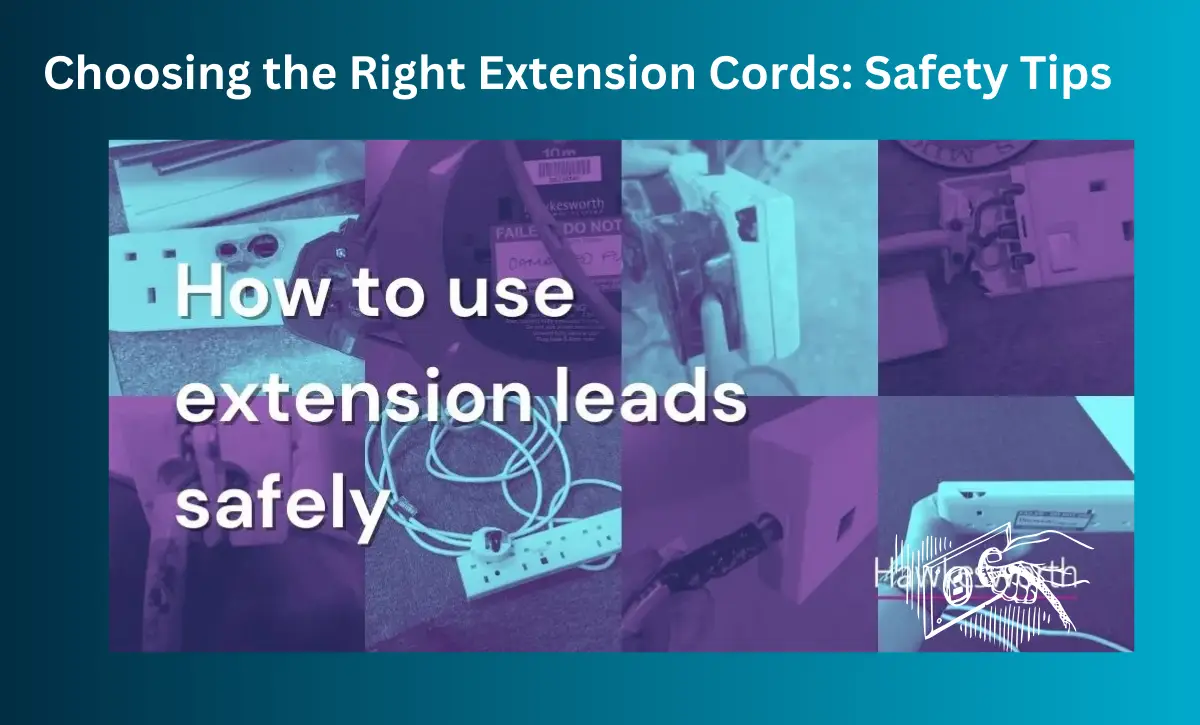In today’s technologically advanced and fast-paced society, extension cords are a must-have item for any home or business. They make it easy to connect a wide range of electronic gadgets and appliances to a single wall outlet. On the other hand, fires and electrical injuries can result from their abuse or the use of improper extension cords. Therefore, it is critical to choose the correct extension cord while following safety tips. If you want to know how to use extension cords safely and efficiently, this article is for you.
Who Needs This Guide?
If you use any kind of electrical device or appliance, you should read this guide. Knowing which extension cord to use is crucial whether you’re a homeowner aiming to decorate with holiday lights, a do-it-yourself enthusiast working with power tools in your workshop, or someone establishing a home office with numerous devices. The proper use of extension cords is essential in commercial settings to avoid accidents and maintain safety standards, so this is of the utmost importance to those working in those fields. Basically, this is a must-read for anyone who wants to know how to use extension cords safely, efficiently, and reliably.
Extension Cord Basics
It is essential to grasp the fundamentals of extension cords before delving into particular safety advice and suggestions. This necessitates familiarity with various kinds, as well as their ratings and recommended applications.
Gauge Matters
The extension cord’s gauge is a measure of the inner wires’ thickness. Wires with a lower gauge number are thicker and hence more suited to power tools and other equipment that require a greater current carrying capacity. In order to choose an extension cord that can safely manage your devices’ power needs without overheating, it is essential to understand the gauge.
Length and Power Rating
An extension cord’s power carrying capacity is proportional to its length. Power drops, caused by longer cords, can impact how well your devices work. In addition, the maximum safe power that an extension cord can transmit is indicated by its power rating, which is expressed in watts or amps. In order to use your appliances safely, you must match this rating with their power requirements.
Indoor vs. Outdoor Use
Whether you’re inside or out, extension cords are made to handle the elements. Insulation on outdoor extension cords is stronger, making them more resistant to moisture, temperature changes, and the elements. Risk injury or property damage by bringing an indoor extension cord outdoors.
Safety Features
Be wary of extension cords that don’t have built-in safety features. For example, a circuit breaker can prevent overloads by cutting power to the cord if it gets too hot.
Recognizing and Avoiding Hazards
To avoid accidents and make sure everyone is safe, it’s important to know what risks can be involved with using extension cords.
Preventing Electrical Fires
Overloaded, damaged, or incorrectly used extension cords pose a fire hazard. To keep your electrical cords safe from fire, you should never use more power than the rating, check them often for damage, and keep rugs and furniture away from them.
Avoiding Tripping Hazards
There is a risk of tripping over extension cords that run across the floor. Use cord covers or run the cords along the wall or behind the furniture so they don’t dangle over footpaths to avoid this.
Proper Storage and Maintenance
The life of extension cords and their protection from damage are both enhanced by proper storage. The best way to store cords after use is to coil them loosely and put them somewhere dry. It is also crucial to check for damage and wear on a regular basis to keep things safe.
Choosing the Right Cord for the Task
When choosing an extension cord, it’s important to think about how much power your appliance needs, whether it will be used indoors or outdoors, and how long the cord needs to be.
What to Look for When Buying an Extension Cord
Make sure the extension cord’s rating and gauge are enough by thinking about the power requirements of the appliance before you buy it. Consider the location of use when deciding if an indoor or outdoor cord is necessary.
Safe Use of Extension Cords with Power Tools
The use of high-current extension cords is common when working with power tools. To avoid overheating and make sure the tools work well, it’s important to choose a cord with the right gauge and power rating.
Alternatives to Extension Cords
Adding more outlets or updating your electrical wiring are long-term solutions to the problem of constantly needing to use extension cords. You can get a safer and more practical power source with these alternatives.
Electrical Safety Hazards
It is critical to identify and eliminate typical electrical safety risks in order to guarantee the safe use of extension cords. By being cautious and being aware, the likelihood of accidents and injuries caused by extension cords can be greatly diminished.
Identifying Damaged Cords
Extension cords that are damaged pose a significant risk to safety. Frayed wires, exposed copper, cracked insulation, and loose connections are things to look out for when something is wrong. Electric shock, fire, and short circuits can result from using a damaged cord. Check your extension cords often for damage or wear, and replace them right away if you find any.
Risks of Daisy Chaining
Daisy chaining is a method of extending a cord’s reach by linking several of them together. But it’s not a good idea to do that since it increases the likelihood of overloading and overheating, both of which can cause fires. Use just one longer extension cord that is rated for the amount of power it can carry to reach your power source.
Overloading Extension Cords
When the combined wattage of all the appliances on an extension cord is more than the cord’s rated capacity, the cord is considered overloaded. Because of this, the cord might get too hot and catch fire. Always double-check the total wattage of the appliances you want to connect to your extension cord to make sure you won’t overload it.
Temporary Use of Extension Cords
Temporary use is the intended purpose of extension cords. In terms of wiring, they are not long-term fixes. Use that goes on for too long increases the likelihood of damage and danger. Think about adding more outlets or upgrading your home’s electrical system for long-term needs.
Choosing Outdoor Extension Cords Safely
The usage of extension cords is common for outdoor projects. To avoid mishaps, choose the correct cord and use it properly.
Selecting Weatherproof Extension Cords
Make sure the extension cord is weatherproof before using it outdoors. Seek out cables that are marked as being resistant to water or weather. These cords are more resistant to water, extreme heat or cold, and even sunlight thanks to their thicker insulation.
Understanding Power Requirements for Outdoor Tools
The power needs of outdoor power tools, like trimmers and lawn mowers, tend to be higher. Verify the extension cord’s amperage rating against the tools’ requirements. If you use a cord that isn’t up to snuff, you risk damaging the tool and the cord.
Safe Placement to Prevent Accidents
Be careful not to tangle extension cords and keep them away from any bodies of water when you use them outside. If you must run a cord across a busy street or driveway, at least use cord covers to keep the cords out of the way.
Storage and Care for Outdoor Cords
It is important to store outdoor extension cords correctly after each use to avoid damage. After washing them, dry them thoroughly, coil them loosely, and put them somewhere dry to keep them. This keeps the insulation from wearing down and the cord from wearing out prematurely.
Alternatives to Extension Cords
The use of extension cords for most of your electrical needs may be a sign that your present system is inadequate. In the long run, these alternatives and solutions will work.
Installing Additional Outlets
By adding outlets where they are most needed, you can significantly decrease the use of extension cords. The dangers of using extension cords are eradicated, and a permanent, risk-free power source is provided.
Upgrading Electrical Systems
It is possible that older homes are ill-prepared to manage the electrical demands of today. Improving the security, expanding the capacity, and decreasing the requirement for extension cords are all benefits of upgrading your home’s electrical system. To make sure everything is up to code in terms of safety, it requires expert evaluation and installation.
Using Power Strips with Surge Protection
Think about utilizing power strips that have surge protection built in for multiple devices in one spot. With this, you can safely charge numerous devices at once without worrying about damaging them with sudden voltage spikes. Be careful not to overload power strips and to select models with sufficient ratings for your electronic devices.
Wireless Solutions and Technology
With the advent of wireless solutions, the need for extension cords can be reduced or eliminated in certain situations, thanks to technological advancements. Wireless charging pads, appliances that run on batteries, and smart home gadgets are just a few examples of things that can make life easier and less chaotic.
Frequently Asked Questions
1. Can I use an indoor extension cord outside?
Using an extension cord that was designed for indoor use outside poses risks of damage and injury because it does not have enough insulation to endure the elements.
2. How many watts can an extension cord handle?
An extension cord’s wattage capacity is proportional to its length and gauge. You should always verify the power requirements of the appliance with the cord’s rating.
3. What is the difference between gauge numbers for extension cords?
The greater the current-carrying capacity of a wire, the lower its gauge number. Particularly for power tools and appliances, this is crucial.
4. How to repair a damaged extension cord?
It is generally advised to replace broken extension cords instead of trying to fix them, particularly if the damage is severe, for safety reasons.
5. What are some best practices for using extension cords with holiday lights?
Be careful not to overload your lights by daisy-chaining extension cords; instead, use outdoor-rated cords whose wattage ratings match those of your lights.
Final Words
In conclusion, you can make sure your appliances and devices are used efficiently and safely by selecting the correct extension cord and adhering to safety tips. Choosing the right cord for your needs, checking them often, and replacing damaged ones quickly should always be your top priority when it comes to safety. The convenience of extension cords doesn’t have to come at the expense of safety if you know the basics and follow the best practices.

Shannon Reyes is a seasoned writer with a knack for crafting engaging blogs on a variety of service industries, including plumbing, cleansing, moving, pest control, and roofing. With a keen eye for detail and a passion for helping readers navigate complex topics, Shannon brings her expertise to life through informative and accessible content.










